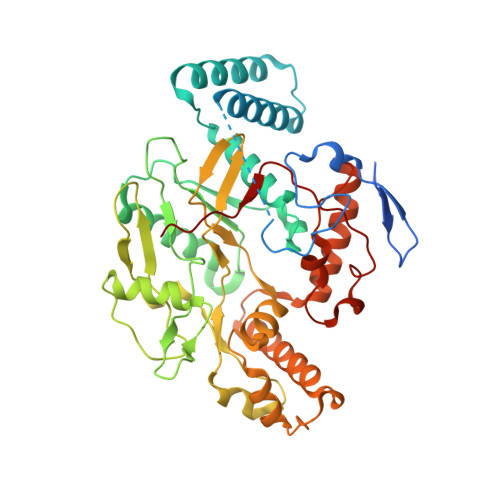First Contact: 7-Phenyl-2-Aminoquinolines, Potent and Selective Neuronal Nitric Oxide Synthase Inhibitors That Target an Isoform-Specific Aspartate.
Cinelli, M.A., Reidl, C.T., Li, H., Chreifi, G., Poulos, T.L., Silverman, R.B.(2020) J Med Chem 63: 4528-4554
- PubMed: 32302123
- DOI: https://doi.org/10.1021/acs.jmedchem.9b01573
- Primary Citation of Related Structures:
6PMV, 6PMW, 6PMX, 6PMY, 6PMZ, 6PN0, 6PN1, 6PN2, 6PN3, 6PN4, 6PN5, 6PN6, 6PN7, 6PN8, 6PN9, 6PNA, 6PNB, 6PNC, 6PND, 6PNE, 6PNF, 6PNG, 6PNH, 6PO5, 6PO7, 6PO8, 6PO9, 6POA, 6POB, 6POC, 6POT, 6POU, 6POV, 6POW, 6POX, 6POY, 6POZ, 6PP0, 6PP1, 6PP2, 6PP3, 6PP4 - PubMed Abstract:
Inhibition of neuronal nitric oxide synthase (nNOS), an enzyme implicated in neurodegenerative disorders, is an attractive strategy for treating or preventing these diseases. We previously developed several classes of 2-aminoquinoline-based nNOS inhibitors, but these compounds had drawbacks including off-target promiscuity, low activity against human nNOS, and only modest selectivity for nNOS over related enzymes. In this study, we synthesized new nNOS inhibitors based on 7-phenyl-2-aminoquinoline and assayed them against rat and human nNOS, human eNOS, and murine and (in some cases) human iNOS. Compounds with a meta -relationship between the aminoquinoline and a positively charged tail moiety were potent and had up to nearly 900-fold selectivity for human nNOS over human eNOS. X-ray crystallography indicates that the amino groups of some compounds occupy a water-filled pocket surrounding an nNOS-specific aspartate residue (absent in eNOS). This interaction was confirmed by mutagenesis studies, making 7-phenyl-2-aminoquinolines the first aminoquinolines to interact with this residue.
- Department of Chemistry, Department of Molecular Biosciences, Chemistry of Life Processes Institute, Center for Molecular Innovation and Drug Discovery, Northwestern University, 2145 Sheridan Road, Evanston, Illinois 60208-3113, United States.
Organizational Affiliation:





















